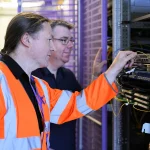The 2021 vs 2020 Top Fastest UK Mobile and Home Broadband ISPs

ISPreview.co.uk is today taking a quick look back over the past 12 months to see how the average UK internet download and upload speeds have changed across the top national fixed line home broadband ISPs and mobile operators. Suffice to say that 2021 has marked a return to the usual trend of general improvement.
The results below tend to be impacted by a number of factors, such as the rising coverage of faster network technologies (e.g. full fibre and 5G) and any associated take-up by consumers. In that sense, it helps to understand any key changes in network deployments since the start of the year, and there have been a few. Ofcom’s latest coverage data helps to put the fixed line market into context (take the 7% figure for gigabit take-up with a pinch of salt as it only applies to 1Gbps+ packages on FTTP lines).
| Fixed Connection | 2021 Coverage (2020) | 2021 Take-up (2020) |
| % Under 10Mbps (USO) | 2% (2%) | (no data) |
| Superfast (30Mbps+) | 96% (96%) | 69% (60%) |
| Gigabit (1000Mbps+) | 47% (27%) | 7% (n/a) |
| Full Fibre (FTTP) | 28% (18%) | 24% (25%) |
The main fixed line developments during 2021 stem from two areas. Firstly, the increasingly rapid rollout of Fibre-to-the-Premises (FTTP) technology from multiple operators (Summary of Full Fibre Build Progress), albeit particularly Openreach’s accelerated £15bn commitment to reach 25 million UK premises by December 2026 (here and here).
Advertisement
Secondly, most of the 2021 surge in “gigabit” coverage, which is also partly fuelled by FTTP, actually stemmed from the completion of Virgin Media’s (VMO2) move to upgrade their existing Hybrid Fibre Coax (HFC) network to the new DOCSIS 3.1 standard – alone this covers c.65% of UK premises (this is not yet reflected by Ofcom’s older data above). The D3.1 completion means that future “gigabit” growth will slow because FTTP takes longer to build from scratch, and there’s growing overbuild between networks (e.g. urban areas).
However, fixed lines weren’t the only area to see improvement, with mobile operators also making headway. On the one hand, we’ve had a gradual boost to rural 4G coverage from progress via the £1bn Shared Rural Network (SRN) project (here). Ofcom currently report geographic 4G coverage by all operators as 69% and outdoor population coverage as 98%.
On the other hand, 5G coverage, particularly in urban areas, is starting to have an impact on speeds too and Ofcom’s recent auction of the 700MHz and 3.6-3.8GHz bands will no doubt boost that (here), albeit probably more so during 2022 (upgrades are gradual). Sadly, the regulator itself has not yet released any solid UK coverage figures for 5G.
Fastest Fixed Line Broadband ISPs (H2 2021)
The following results stem from Thinkbroadband’s independent speedtest database (including ISPreview’s Broadband Speedtest). In this study, we’ve only included independent ISPs with strong national availability, although there is a separate table for smaller alternative network ISPs on page 2 – these are difficult to include because they aren’t yet available to the majority of premises and thus don’t produce many data samples.
Advertisement
Naturally, there are some common caveats to consider with speedtest based results, not least that such scores tend to be more reflective of take-up than network availability. For example, some ISPs may have a much larger proportion of customers on slower copper ADSL or FTTC lines and that can weigh against anybody on faster FTTP or gigabit packages with the same provider (i.e. pulling average speeds down).
| No. | Operator | 2021 (Top 10%) | 2020 (Top 10%) | Change % |
| 1. | Virgin Media | 153.5Mbps (371Mbps) | 118.3Mbps (236.9Mbps) | 29.75% |
| 2. | Zen Internet | 91.3Mbps (228.3Mbps) | 40.8Mbps (70.7Mbps) | 123.77% |
| 3. | iDNET | 83.9Mbps (90.7Mbps) | 42Mbps (71.5Mbps) | 99.76% |
| 4. | BT | 61.4Mbps (117.2Mbps) | 46.2Mbps (72.8Mbps) | 32.9% |
| 5. | AAISP | 52.9Mbps (73.8Mbps) | 53.6Mbps (99.8Mbps) | -1.31% |
| 6. | Vodafone | 51.7Mbps (73.8Mbps) | 45.1Mbps (71.6Mbps) | 14.63% |
| 7. | Sky Broadband | 37.9Mbps (69Mbps) | 27.7Mbps (58.5Mbps) | 36.82% |
| 8. | TalkTalk | 37.4Mbps (69.8Mbps) | 28Mbps (56.6Mbps) | 33.57% |
| 8. | EE | 34Mbps (65.7Mbps) | 30.4Mbps (62.8Mbps) | 11.84% |
| 10. | Plusnet | 29.1Mbps (60.2Mbps) | 25.6Mbps (53.2Mbps) | 13.67% |
Average Upload Speeds – Top 10
| No. | Operator | 2021 |
2020 |
Change % |
| 1. | Zen Internet | 25.5Mbps | 14.3Mbps | 78.32% |
| 2. | Virgin Media | 18.4Mbps | 14.9Mbps | 23.49% |
| 3. | iDNET | 16.5Mbps | 10.3Mbps | 60.19% |
| 4. | Vodafone | 16.2Mbps | 13.3Mbps | 21.8% |
| 5. | BT | 14.2Mbps | 11Mbps | 29.09% |
| 6. | AAISP | 14.1Mbps | 14Mbps | 0.71% |
| 7. | Sky Broadband | 9.8Mbps | 7.1Mbps | 38.03% |
| 8. | TalkTalk | 9.4Mbps | 7Mbps | 34.29% |
| 9. | EE | 7.8Mbps | 7.3Mbps | 6.85% |
| 10. | Plusnet | 6.9Mbps | 6.1Mbps | 13.11% |
Overall, the average download speed of the top national providers was 63.31Mbps (up from 45.77Mbps at the end of 2020) and the average upload speed hit 13.88Mbps (up from 10.53Mbps). Overall, almost every single ISP saw an improvement in their broadband speeds, and some (e.g. iDNET and Zen) were much more dramatic than others.
As highlight in our introduction, the main drivers here are increasing adoption of ultrafast and gigabit broadband packages, thanks both to the rapid rollout of “full fibre” FTTP services and Virgin Media’s (VMO2) national DOCSIS 3.1 upgrade. Clearly, iDNET and Zen must be doing a good job of converting their copper base to FTTP with those uplifts (we know that Zen has seen strong take-up of FTTP and it shows).
Advertisement
On the flip side Plusnet, which during this period was the only provider above to lack any ultrafast packages, saw only a small increase. However, it’s unclear why EE, which has a fairly strong range of competitively priced FTTP plans, isn’t seeing a bigger uplift (perhaps parent BT is stealing their thunder in more ways than one) and we’re similarly surprised by Vodafone.
As for AAISP, they’re a much smaller provider and the tiny sample size can make it hard to spot key changes, thus we aren’t reading too much into their results but they don’t seem to have improved at all in 2021.
Now flick over to page 2 to see how the fastest full fibre alternative network (altnet) ISPs and mobile operators performed.
Mark is a professional technology writer, IT consultant and computer engineer from Dorset (England), he also founded ISPreview in 1999 and enjoys analysing the latest telecoms and broadband developments. Find me on X (Twitter), Mastodon, Facebook, BlueSky, Threads.net and Linkedin.
« GBP900k to Help Rural Homes in Powys Get Full Fibre Broadband UPDATE






















































Take up is irrelevant, availability is what matters.
Take up is what pays the providers bills. It’s a combination of both.
People Fibre would disagree as lack of customers bankrupted them.
I don’t think it’s just a lack of customers that bankrupted them.
Even if they had 10 times the number of customers, that’s still only 1,500 customers. That would be a take up rate of nearly 30%, which is huge.
Even that wouldn’t have covered their £150,000 a quarter losses.
People’s Fibre didn’t have enough capital to start with and burnt through what cash they did have very quickly.
They made a mess of picking what areas to deploy in, having to change their mind a couple of times after picking areas already being built with FTTP by Openreach.
Even the areas they eventually started building in they weren’t the only operator rolling out/planned to roll out FTTP.
People on this site tend to have a massive misconception on what the general public care about. It seems the Alt nets have fallen for this too by basing market research on groups that care about the ins and out of broadband, for example Swish fibre having 150 customers.
Most don’t care what it is, only that it does what they want. If 40/10 FTTC streams Netflix on FTTC for £20 then most won’t care about moving. Price > FTTP speeds.
Most only care if they can do what they want, this means things like browse Facebook and not cause Netflix to freak out etc.
For most people’s needs 40Mb is more than enough.
As technology moves on then higher gigabit speeds will be the norm but there needs to be a good use case for the average user to need it first.
The testing of mobile data really needs a framework in place to give us any viable results. Like picking 5 random masts in each region randomly across the UK and testing them at different times of day for a week.
Using speed test data from across the country from here or thinkbroadband’s speedtests isn’t anywhere near as accurate.
Still currently sitting at 3.3/0.8mbps. don from 6/1 few months ago. Fibre/super fast is still promised but not until late next year… For the 8th year running.
Tried 4g?
You thought wrong Sir. Its only nerds who insist everyone MUST sign up for Gigabit speeds (where available) and why Openreach not offering symmetric speeds on FTTP is the ultimate sin.
I am an IT pro, tech enthusiast and have been an internet user for nearly 30 years. However, I have no need for gigabit speeds even though they’re available to me. My 100/100 FTTP service is good enough for mine and my family needs.
Anything more would, for now, be a waste. That’s not to say I won’t want more in the future.
I recently upgraded my phone in a EE store I saw that there was no EE Home broadband on show or information in store only BT,even when I completed buying my phone the salesman was pushing me to take up BT broadband i asked why are you not selling EE broadband in store as it is an EE store all he said it’s because EE/BT are the same company as we all know but the only answer is to push up BT’s sales
FTTC is past its sell by date.
@Sam
FTTC is past its sell by date.
Yep, by over 20 years, nice to see UK has dropped a point in the global broadband speeds.
An 11 year old deployment of what was a new technology is 20 years past its sell by date??
Really?
@Dankshire
I can assure you if FTTC hadn’t been rolled then FTTP progress would have been helluva a lot slower until now. That’s because FTTC brought full fibre aggregation nodes a lot closer to peoples homes.
@John & Billy Goat Gruff
read
https://www.eff.org/files/2020/01/24/south_korean_telecommunications_memo.pdf
and ask yourself, why did the UK miss the opportunity?
I agree FTTC in 2021 is unfit for purpose, the way its still allowed to be sold misleading people that its a fibre product is a travesty.
“for example Swish fibre having 150 customers.”
Swish Fibre have a lot more than 150 customers.
That would be People’s Fibre, who Swish just acquired.
People’s Fibre are a brand new Alt-Net who have covered just over 5,000 properties, the majority of that covered in the last 6 months.
It’s a low take up rate either way (less than 3%).
Most people will still be within their minimum term with their current ISP during that 6 months.
They are also 1 of the smaller/newer Alt-Nets with little publicity and few existing customers to give recommendations.
It’s very hard to gauge appetite from take up figures in the 1st 6 months from deployment.
I think it is down to a lag between the rolout of FTTP and people taking it up. Whilst the basic spwed most people use can be low things change when you have mutiple uses of that bandwith. You may have two or three users in a hiome. The TV may be usining it. Smart heating controls may be using it as well ass video doorbells
With BT quite quickly moving to VOIP I think things will change. The default will be every one will have a Broadband line. WE also are having more people working from home
Longer term costs are likely to fall as the old analoge network becomes redundant so big cost savings longer term. In the short term though there is a lot of capital investment
As happened with cable TV we will see consoldation of the alt networks.
What I find surprising is Sky is not yet really involved with FTTP they could get left behind. I suspect they might start taking over some alt networks but at present most are small players so may not be of interest.
british people need 1mbps for facebook everything else is not important i guess. They not very advanced when it comes to technology. And even disagree about getting faster better broadband service hahahaha
Having taken fttp 500/70 package with Talktalk and voip I would not want to go back to fttc. It not just the speed improvements but the reliability that’s so must better than with copper. I was previously an A&A customer but decided to give Talktalk as try as their pricing and speed packages wereveryappealing. I have to admit I was a more than a bit apprehensive due to their CS record but I have been very pleased with their service to date, helped by their uk based full fibre call centre.
Im pretty sure with time the take up of fftp’s growth will be substantial. Like with all new technologies it takes time for the general public to adapt and embrace change. We have to remember that the UK are years behind in the deployment of fibre but finally we are making headway and thus public perceptions will also catch up.
With the limited availability of FTTP most people are unaware of it. The markettinmg of FTTC as Fibre is confusing to many as well as they dont understand the difference between FTTC & FTTP
Marketing of FTTP is poor as well and mainly focuses on Speed rather than reliability and the ability to relibaly support multiple useand users without degrading performance